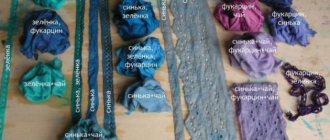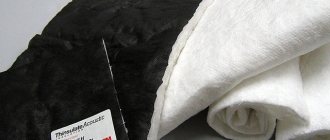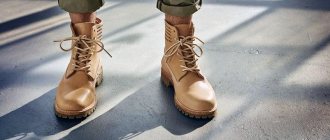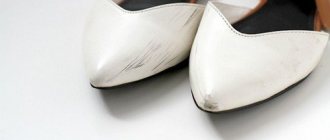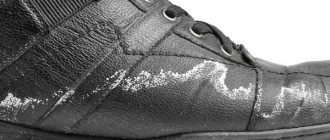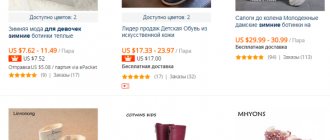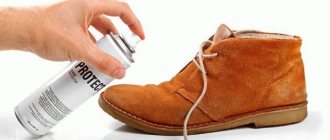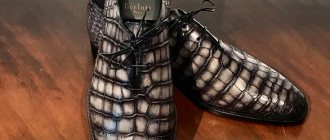In winter, you especially want to feel warm and comfortable, so choose your winter shoes carefully. Pay attention to the materials of the upper and lining. In one of the articles we discussed genuine leather and nubuck. Now let's look at internal insulation. So, what is warmer: fur or wool? What material is preferable for the winter season? Manufacturers use felt, natural and artificial fur, fleece, and sheepskin as lining. They warm your feet, are pleasant to the touch, and provide air exchange inside the shoes. Boots and shoes use fur and wool as lining. We chose these materials because of their good performance.
Properties of wool in shoes
The most popular material used in the production of shoes is sheepskin. Unlike sheepskin, which is used for clothing, the option for shoes is not as thick. Sheepskin is also very popular among buyers, because it is comfortable and has an attractive appearance, and also has a number of other advantages. This:
- Sheepskin fibers, due to their structure, create a layer of warm air. This helps ensure warmth and dryness;
- The material is completely natural and cannot cause allergies or redness on the skin. Also, sheepskin does not harbor various microorganisms that can harm human health;
- Sheepskin has anti-inflammatory properties. The substances included in its composition provide an antiseptic effect. And thanks to lanolin, which is contained in wool hairs, swelling of the lower extremities is relieved;
- Hygroscopicity. Sheepskin is quite difficult to get wet. It can remain dry even with prolonged exposure to water;
The disadvantages of sheepskin include:
- High price. This is the most expensive lining material;
- Low wear resistance. During wear, the sheepskin begins to be trampled and worn out, which is why it loses its heat-saving properties;
When is it better to choose wool and when to choose fur?
You should choose a pair of winter boots based on the climate in which you live . If you have to spend a long time without moving in frost below 15 degrees, then it is better to have shoes with natural fur.
For those who, at this temperature, quickly reach their goal in 15–20 minutes, wool insulation is preferable, since, firstly, such a pair weighs lighter and is more convenient to walk quickly in, and secondly, during this time during active movement your feet are unlikely to have time to sweat. But even if such a nuisance happens, quickly drying these shoes will not be a problem.
If in your area the winter temperature does not drop below -15 degrees, it is more advisable to wear boots with woolen fur inside - your feet will not overheat, and walking in them will be much easier. In addition, the range of dress shoes made from this material is much wider.
The choice is yours, but when buying, pay attention to the smell of the new pair: if you can clearly feel the chemistry, look for something else for yourself. High-quality materials should smell pleasant.
Frost resistance of winter sneakers
DIY Hawaiian skirt
Properties of fur
Fur, which is used to insulate shoes, can be natural or artificial.
Artificial
This is a completely synthetic material that only imitates a natural product. It consists of a base and pile. Despite the fact that this is faux fur, it has recently become very popular among buyers. This is due to the following:
- Low cost compared to natural analogues;
- It is completely environmentally friendly;
- In appearance it is not inferior to natural products;
- It can be painted in various colors, which can serve as an excellent decoration for shoes;
- It is quite easy to care for;
However, it has a significant drawback. Since this is a synthetic material, it is airtight and the skin does not breathe in it, which leads to increased sweating.
Common materials
Types of linings are divided into 2 groups: artificial and natural. It is believed that there is no better material than genuine leather. In modern production it is possible to produce linings from artificial fibers whose characteristics are not inferior to “natural” competitors.
To make winter shoes, sheepskin, combined, artificial fur, and felt are used. A synthetic base like Thinsulate retains heat well, and the leather is suitable for autumn and spring.
Leather
Natural has a high cost, so it is used in the line of premium brands. Some manufacturers who want to save money sell shoes with linings made from pigskin or sawn grain. However, they quickly fail: after 1-2 months abrasions appear. Initially, pigskin has thermoregulating properties, but after dyeing they disappear.
Chevreau (goatskin) has a dense, smooth surface and is often used in summer models. Cow leather is an ideal raw material for making linings. It is wear-resistant, breathable, durable and soft. Many fashion houses use calfskin for closed shoes.
Leather base is the best option for interior decoration. It has no flaws (except for pork). The product retains heat well and, in combination with pile filling, is suitable for winter. Not every person is able to buy shoes made of genuine leather because of their high price.
Natural fur
Natural and artificial fur is used to make linings for winter shoes. The use of natural sheepskin fur is widespread.
Its advantages include:
- ability to retain heat:
- waterproof;
- hypoallergenic and hygienic;
- versatility.
Sheepskin contains lanolin, a substance that has anti-inflammatory, antiseptic, and antifungal properties. Feet in such shoes do not swell. A significant disadvantage is the high cost of the product.
Combined fur
Models in which natural fur is used on the boot and artificial fur on the foot are now in demand. They look attractive, aren't too bulky, but still keep you warm.
The material has many advantages:
- moisture absorption;
- breathability;
- antibacterial properties;
- wear resistance.
The combined base contains beneficial substances that penetrate the skin and have a positive effect on blood circulation.
Artificial fur
The raw material for artificial fur is textiles and pile glued to it. It is almost impossible to distinguish it from its natural counterpart.
The advantages of faux fur products include:
- low price;
- ease of care;
- environmental friendliness;
- variety of colors and shades.
Among the disadvantages is that the feet begin to sweat when worn for a long time. Over time, shoes begin to smell bad. Expensive products have a leather insert on the heel. In its absence, the fur wears out and breaks.
Printed wool
Wool fur is a budget replacement for natural fur; it is made by stuffing wool fibers onto textiles. Natural bases are good for sub-zero temperatures, while artificial ones sell well in temperate climates. Feet in such boots do not freeze, and the fur dries quickly.
Advantages:
- high wear resistance;
- low price;
- analogue of a natural product.
At temperatures below -30°C it loses its thermal properties, which is a significant drawback.
Felt
This type of lining material is useful and environmentally friendly. Felt base retains warmth in extreme temperatures. Boots for winter fishing are made from it. Wool absorbs moisture, retains heat, and prevents the development of fungal infections. Felt shoes are recommended to be worn for joint diseases.
The wool contains wax, which improves blood circulation; in addition, it has a massage effect. Felt is an extremely durable material. Even with prolonged use it does not lose its shape. The more tightly the fibers are woven, the better the product retains heat.
A relative disadvantage is that it is not suitable for warm and temperate climates, even in winter.
Thinsulate
Modern synthetic material was originally produced to insulate astronaut suits. It is light, thin, ventilates the legs, but does not allow moisture to pass through. Thinsulate can compete with natural fur in its ability to store heat. Shoes with a synthetic lining provide protection at temperatures not lower than -30°C.
The material is a weave of synthetic fibers that form air pores. In terms of characteristics, Thinsulate is superior to fluff.
Its characteristics are:
- ease;
- elasticity;
- safety;
- environmental friendliness;
- hypoallergenic;
- versatility;
- moisture resistance;
- permeability;
- wear resistance;
- ease of care.
Thinsulate is made on the basis of polyesters. It is used for everyday shoes. There are models for extreme sports.
The disadvantage of synthetic filler is that over time it loses its heat-insulating properties. This occurs due to violation of operating and storage conditions. It does not tolerate high temperatures.
Membrane
Membrane-type linings are environmentally friendly and hygienic. The cellular structure of the material allows the skin to breathe. Perforated insoles remove moisture, which prevents inflammatory and fungal diseases.
There are several membrane options:
- It is characterized by a spongy structure, absorbs water, dries quickly, is hygroscopic, resistant to deformation and abrasion. The characteristics are similar to products made from genuine leather. It is used in the manufacture of sports, hiking, and work shoes.
- Thermal insulation material, an artificial analogue of down. Good for use in adverse weather conditions, withstands severe frosts. Suitable for insulating children's shoes.
- Core-Tex. It has a three-layer structure: outer fabric, membrane, lining. The membrane fabric retains its properties at a pressure of 6,000 mm of water column, is also resistant to moisture penetration, protects against cold, and is breathable.
The manufacturer produces models suitable for everyday wear, sports, and intense physical activity. Some of them are suitable for temperate climates. Insoles are made from membrane multilayer material for use in conditions of extremely low temperatures and sudden changes in weather. The disadvantage is that if you stay outside for a long time in wet weather, your feet will sweat.
Each lining material has advantages and disadvantages, regardless of its nature. When purchasing shoes, the most important factors are the purpose for which they are purchased, how often they will be worn, and in what weather conditions.
How and from what is the wool lining of boots made?
To make a wool lining, the shorn wool is washed, combed and woven into a flexible, breathable backing, usually made of polyester or Dacron. Sometimes natural wool threads are included in it. The pile can consist not only of wool; synthetic fibers are often added to it. In this case, the hygienic and heat-protective properties deteriorate, but such material is cheaper, more wear-resistant, lightweight and thin, which allows you to sew more elegant shoe models. The most common combination of wool and synthetic fiber is 4:1.
Story
Bike material - what is it? Warm wool fleecy material. In the Middle Ages, things from it were purchased by travelers or those who had to stay outdoors for a long time. Initially, the fabric was brown, then they learned to dye it in soothing colors.
It appeared in Russia with Peter I. The word is translated from Polish as “woolen material.” It was used for sewing clothes, scarves, linings, and blankets by people of different incomes. Black without shine, baize is a fabric that was used in the 18th century to make mourning robes. A century later, it began to be used for sewing men's coats, warm clothes, and riding suits.
The article “Which is warmer: sheepskin, fur or felt?”
For your information: felt boots from the Kotofey brand are made from an environmentally friendly product - natural Australian merino sheep wool.
What is warmer: sheepskin, fur or felt?
Winter is just around the corner. And he went and bought himself some sneakers. “He says they are more beautiful”
To retain heat in the production of winter shoes, 3 materials are usually used: natural sheepskin, artificial fur made from natural wool and shoe felt. Let's consider the properties of each of them.
Sheepskin
for shoes has a low pile density compared to sheepskin used in the production of outerwear. At the same time, millions of pairs of shoes with sheepskin lining are sold in Russia every year. Some feel comfortable in it, some find it cold, some find the fur quickly erased from the sheepskin, some don’t. It all depends on the integrity of the manufacturer of sheepskin and shoes made from it, respectively.
We also produce shoes with this type of lining and would like to note that the quality of sheepskin shoes has rapidly deteriorated over the past 10 years. The air in sheepskin is located between the fibers. Most often, sheepskin fibers have slight intertwining with each other and are very mobile. This gives too much freedom to the air between the fibers, which cannot be said about wool fur.
, the fibers of which are much more tangled with each other.
In felt
, the entanglement of fibers is brought to the maximum, since this property determines the structure of the material itself.
Composition of the bike
Previously, this type of material was produced only from wool fibers. But the price of natural flannelette fabric made from wool was too high. Subsequently, cotton threads began to be added to the composition of such fabric. After this, the material began to differ not only in its high consumer qualities, but also in its reasonable price.
Important! to the composition of such fabric to reduce the cost of the fabric.
It must be taken into account that such additives significantly reduce the heat-protective and hygienic properties of such a material. In addition, the lint of unnatural fabrics rolls off very quickly.
Tips for choosing
You can buy flannelette material at any fabric store or online store. To choose high-quality material, you should pay attention to the following:
- natural composition of wool or cotton without the addition of viscose or other synthetic fibers; the fabric should be dense, the pile should be thick; the paint does not remain on the skin, the smell should not be harsh or chemical; natural fabric does not stretch, but with the addition of artificial fibers it becomes more elastic; This is an inexpensive material, but completely natural cannot be very cheap, especially wool.
Fleece material, what is it? Universal warm fabric for various things. A blanket or pajamas made from it will warm you up and add comfort on a cold winter evening.
What this material looks like, photo:
Soft, warm flannelette fabric has been familiar to many since childhood. This material is used to make blankets, winter blankets, clothes for children and adults, and is also used as a lining for clothes. But besides this, due to its performance characteristics, the bike is also used as a lining for shoes.
Where is it used?
You can sew a variety of things from this fabric. What is made from wool:
- warm blankets of different sizes; used in shoes as an insole; outerwear, coat; lining made of flannelette for warm clothes.
The cotton variety is suitable for the following products:
- cozy blankets, bed linen; bathrobes, pajamas, household items, suits; sports items, sweatshirts; children's home clothes - pants, vests, blouses.
Shoe jacket popular among the military. Foot wraps are made from it. This is due to its low price, good absorbency and heat retention. At industrial enterprises, machines and equipment are wiped with pieces of cloth.
The inner material of the bike is used to insulate winter shoes. This is the wool version. The pile is combed tightly, this makes the fabric soft. These boots are comfortable and convenient, your feet are not hot, and moisture is quickly removed. Shoe lining made from this fabric is also used for demi-season shoes. There are more subtle options for it.
Nowadays woolen fabric is rarely available for sale. Usually cotton or with added wool.
Overview of types of winter shoes
Now you can make a kind of rating of warm women's shoes for winter. When choosing, be guided by:
- on the average and maximum temperature in the region of residence;
- precipitation - how often does snow fall and how long does it last;
- intensity of wear - walk every day or once a week;
- purpose – for working outside, walking, fast walking;
- individual characteristics - how quickly and at what temperature the feet freeze.
High boots are the warmest boots in the world due to double-sided fur located inside and outside. In modern models, the outer fur on the tops is more decorative, combined with fur coats and fur collars. There is fur from raccoon, arctic fox, mink, and fox. Beautiful high boots do not look bulky.
Uggs , which come in second place, are made of sheepskin with the pile inward and the smooth side outward. Natural sheepskin prevents body temperature from decreasing and quickly removes moisture. The outside is not cooled. Ugg boots with synthetic fur do not have such properties.
Felt boots are in third place, because here you need an extra warm sock. Good felt boots are durable, because chain mail for warriors was once felted in the same way. But all the advantages apply only to natural wool; imitation is suitable for southern regions, where in winter the temperature is close to zero. Read how to choose felt boots in our other article.
But the industry does not stand still. For those who do not want to overpay for expensive natural fur, they came up with snow boots. The bottom of these shoes is made of moisture-resistant materials, and the top is made of textiles.
Inflated boots are indeed slightly inflated due to the air contained in the filler. The principle here is the same as with quilted jackets and down jackets. Air is a good heat insulator and does not release heat from the body. Pairs well with sports jackets, quilted coats, and down jackets.
The line includes models for late autumn, spring, when the snow melts, and winter. Warm winter jackets and snow boots are insulated using membrane technology. Fur or wool is additionally used inside. The lower part is not made of rubber, but of materials suitable for wear in cold weather - suede, leather, artificial raw materials.
Wool insulation
also produces wool-lined shoes. Lightweight winter models will provide comfort and warmth in severe frost. They cost less and look great! Wool and felt have a dense structure. Many weaves keep warm air inside well. The higher the density of the pile, the better the thermal insulation, the warmer the shoes or boots. It is typical that during wear the fibers become even more compressed and compacted. The shoes become warmer.
- Contains natural fibers,
- Has an optimal density of pile filling,
- Shoes can be worn at temperatures from zero to very low,
- Durable, practical, not subject to abrasion,
- Boots or boots with wool insulation are lighter, more elegant,
- Shoes made with natural wool are affordable.
Choose insulation and shoes based on weather conditions, your own feelings, and financial capabilities. We’ll tell you in what cases the first or second material is suitable.
Fur insulation
Natural or artificial material is used. As a rule, this is tsigeika (tanned sheep skin). Thick, long fur seems to be warm, but allows a lot of air to pass through. Retains heat by conserving heat between fibers. Heat saving depends on the method of manufacturing the insulation and the hairiness. Well-filled natural fur is warmer than wool. A material with an insufficiently dense structure does not retain heat inside and is useless in severe frost. We recommend buying shoes from a well-known manufacturer whose quality you are confident in.
Advantages of fur over wool:
- Dense pile creates warmth and dryness inside the shoes,
- Sheepskin is not afraid of moisture, is not hygroscopic,
- Provides feet with “breathing” inside the boot or shoe,
- Feet will not sweat or freeze,
- Creates a comfortable internal microclimate.
Looking for good quality winter shoes? We offer a variety of models with natural fur. The catalog contains options for men and women. The collections are replenished with new items. The product is covered by a warranty.
What kind of fur is used to make winter shoes?
The outer fur trim is made from different types of fur - arctic fox, fox, raccoon, mink, beaver, astrakhan fur, but sheepskin is usually used as the inner lining. It consists of tanned sheep skins. The popularity of this type of fur is explained by its qualities:
- High thermal insulation properties. They are provided by the air layer formed in the hairline.
- The ability to thermoregulate. The layer of air between the villi and the skin allows you not only not to freeze outside, but also not to sweat when you get from the cold to a warm room.
- Hygroscopicity. Capable of absorbing large amounts of moisture while maintaining heat-protective qualities.
- Antibacterial properties. Sheepskin does not harbor ticks, bacteria and other harmful microorganisms do not multiply.
- Hypoallergenic. Sheep fur rarely causes allergic reactions.
- Useful qualities. Sheepskin has antiseptic and anti-inflammatory properties, can relieve swelling, improve blood circulation and relieve joint pain.
- Price. Sheep fur is distinguished from other natural furs by its low cost.
Advantages and disadvantages
- Sturdy, durable. Does not tear under strong impact, does not stretch. Resistant to wear. After a few washes it will take on an appearance that will not change. Good thermal insulation. Thickness, density and thick pile retain heat for a long time. Good breathability. Hygroscopicity - accepts and releases liquid. Therefore suitable for home textiles and clothing. Soft, non-allergenic. Naturalness and twill weaving provide these properties. Pleasant to the touch, cozy and warm. Versatile application. Suitable for a variety of clothes and linen. Low price. Cotton material or with the addition of wool is cheaper. Many different patterns and colors of fabric.
- the wool version weighs a lot; Cotton retains heat worse than wool; Manufacturers often add viscose, this reduces the positive properties of the material.
There are more pros than cons. That's why the material is so popular.
How to further insulate winter shoes
If you bought not the warmest boots for the winter, then insulate them using simple and affordable methods and devices. The same tips will help you update old shoes that are no longer warm enough.
If fullness allows, insert an additional insulated insole . It is better to give preference to insoles made from natural materials - felted wool or fur. It is advisable that the insole be foil on one side. A layer of foil will provide additional protection from the cold, but it should be placed down towards the sole.
For those who have to stand outside or walk a lot on frosty days, there are self-heating insoles and half-insoles. They heat up immediately after peeling off the base. The product must be glued to a sock or tights and immediately put on boots.
Make it a rule to always buy winter shoes one or two sizes larger. There should be plenty of completeness.
- Firstly, warm boots should not be close to each other - an air gap is needed.
- Secondly, in a loose boot you can afford an additional warm woolen sock.
Remember that even the best winter boots lose their properties after three or four seasons. The insulation wears down and falls off, the top is destroyed, the sole becomes porous and wears off. Don't forget to buy new shoes for next winter, catch discounts on sales days.
If you want to share your experience, then tell us which boots are the warmest and how to protect your feet from the cold in winter in the comments. Your advice will help other women stay healthy.
Definition of a tale
Reference! Flannelette fabric is a pleasant-to-touch material with a dense structure and soft pile, produced by plain or twill weaving of cotton, wool or wool blend thread.
It is thanks to the special method of weaving the threads that this type of material has a characteristic dense structure.
The practical flannelette fabric, which appeared in the everyday life of the Russian people at the beginning of the 18th century, was originally woolen and had a coffee tint.
Which boots are the warmest?
The purpose of winter shoes is to prevent cold air from penetrating your feet . No less important is protection from moisture from the outside and its removal from the inside.
Best upper material
First of all, in winter, put aside leatherette boots - they will not cope with the task even in slight frost. If the quality of the leatherette is low, then there is a risk that the shoes will crack. Cold air will definitely enter through the cracks and moisture from the snow will penetrate.
Smooth natural leather looks beautiful, but such boots are not suitable for long periods of exposure to cold in winter. Smooth leather quickly cools and takes on the ambient temperature. And if in 10-20 minutes you do not feel discomfort, then after 30-40 minutes of walking in ten-degree frost, your feet will begin to tingle.
Natural suede is one of the most suitable materials for warm winter boots. Good suede keeps cold air out, but at the same time allows your feet to breathe. In cold weather, the material remains soft and elastic, does not crack or break.
But suede boots are not suitable for slush, which forms during snow melting naturally or after treatment with reagents. Be sure to treat the surface with protective impregnations and clean immediately so that no stains remain.
Natural felted wool is the best material for children's and women's winter boots. Wool was made into warm winter boots that could withstand severe frosts. Despite its apparent vulnerability, wool does not allow cold to pass through and even in strong winds warms your feet. Suitable for dry weather.
Durable, insulated, quilted raincoat fabric is a suitable top for winter boots. In this way, the familiar “dutiki” are made. The top of textile boots is similar to a winter jacket - it is not blown and maintains temperature due to insulation and an air layer. Naturally, the characteristics depend on the quality of the materials.
Choosing the ideal insulation
The purpose of insulation is to maintain body temperature. For winter shoes, it is worth considering two traditional insulation materials - natural fur and natural wool. These materials warm well and do not create a “greenhouse” effect inside.
Natural fur creates a good thermal insulating air cushion due to the many fibers. The fluffier and longer the fur base, the warmer the feet. Most often, sheepskin or sheepskin fur is used for boots. Well-made fur is suitable for frosts up to 30 degrees.
In order to reduce the volume of the boot and reduce the cost of insulation, manufacturers make winter shoes with Eurofur. This term hides the insulation of boots only in the lower part, usually up to the ankle or like a sock. The boot is insulated with thin fur, wool or flannel.
It is impossible to answer the question of what is warmer – fur or wool. This depends on the quality of the raw materials, the processing method and the thickness of the insulating layer. However, high-quality wool is inferior in thermal properties to high-quality fur. The reason is obvious - there is no volumetric air cushion that accumulates heat.
Bike production
Fabric of this type, just coming out of the loom (harshness), does not have a particularly attractive appearance. For this reason, this material is subsequently subjected to additional processing, which includes :
- thorough cleaning;
- plain coloring;
- printing a drawing;
- final finishing.
This allows you to end up with a fabric with a one-and-a-half-layer weave and double-sided brushing. The weave can be finely patterned or large patterned. It depends on the threads used as weft.
Production
Flannelette material is made on a loom, which is why the fabric is called gray fabric. The canvas looks ugly and requires additional processing. Subsequent finishing stages:
- cleansing, preparation; plain coloring; printing a drawing; final finishing.
The result is fabric with double-sided fleece. The weaving will be finely patterned or large patterned depending on the type of weft threads. A woolen flannel is made using twill weaving. This makes it softer.
